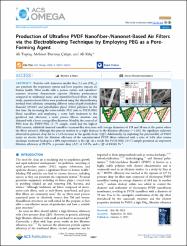Production of ultrafine PVDF nanofiber-/banonet-based air filters via the electroblowing technique by employing PEG as a pore-forming agent
Citation
Toptaş, A., Çalışır, M. D., & Kılıç, A. (2023). Production of Ultrafine PVDF Nanofiber-/Nanonet-Based Air Filters via the Electroblowing Technique by Employing PEG as a Pore-Forming Agent. ACS omega, 8(41), 38557–38565. https://doi.org/10.1021/acsomega.3c05509Abstract
Particles with diameters smaller than 2.5 μm (PM2.5)
can penetrate the respiratory system and have negative impacts on
human health. Filter media with a porous surface and nanofiber/
nanonet structure demonstrate superior filtration performance
compared to traditional nano- and microfiber-based filters. In this
study, nanostructured filters were produced using the electroblowing
method from solutions containing different ratios of poly(vinylidene
fluoride) (PVDF) and polyethylene glycol (PEG) polymers for the
first time. By increasing the water-soluble PEG ratio in PVDF/PEG
blend nanofibers and employing a water bath treatment to the
produced mat afterward, a more porous fibrous structure was
obtained with a lower average fiber diameter. Notably, the removal of
PEG from the PVDF/PEG (3−7) sample, which had the highest
PEG content, exhibited clustered nanofiber-/nanonet-like structures with average diameters of 170 and 50 nm at the points where
the fibers intersect. Although this process resulted in a slight decrease in the filtration efficiency (−1.3%), the significant reduction
observed in pressure drop led to a 3.2% increase in the quality factor (QF). Additionally, by exploiting the polarizability of PVDF
under an electric field, the filtration efficiency of the nanostructured PVDF filters enhanced with a ratio of 3.6% after corona
discharge treatment leading to a 60% improvement in the QF. As a result, the PVDF/PEG (3−7) sample presented an impressive
filtration efficiency of 99.57%, a pressure drop (ΔP) of 158 Pa, and a QF of 0.0345 Pa−1.


















